Key takeaways:
- Phishing exploits emotions like fear and urgency, making individuals more susceptible to scams.
- Recognizing signs of phishing, such as urgent language, poor grammar, and suspicious links, is crucial for protection.
- Sharing personal experiences and knowledge fosters a supportive community, enhancing collective awareness and security against phishing.
- Implementing prevention techniques, including multi-factor authentication and regular training, significantly reduces phishing risks.
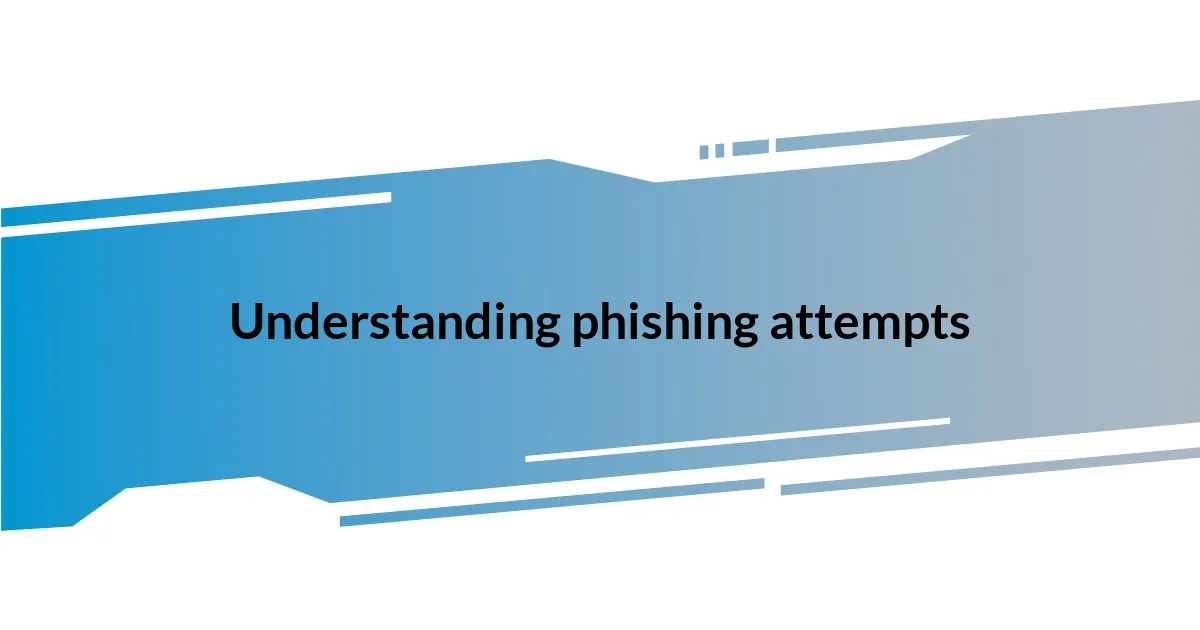
Understanding phishing attempts
Understanding phishing attempts has become increasingly crucial in our digital age. I vividly recall opening an email that looked like it was from my bank, urging me to verify my account. The panic that set in was palpable; I almost clicked the link. What really struck me was how convincingly it mimicked the bank’s communication style. It made me question: how many people fall for these scams simply because they trust what they see?
At its core, phishing preys on our emotions—fear, urgency, and curiosity. I can still remember that feeling of dread when I thought I might lose access to my financial information. I found it fascinating how these attempts often craft a story that tugs at those emotions, creating an illusion of necessity. Have you ever received a message that made your heart race, urging you to act immediately? It’s a powerful tactic that underscores the importance of taking a step back and assessing what’s real.
Phishing attempts vary widely, from emails to texts and even social media messages. I’ve encountered countless scenarios where a “trusted friend” sent me a suspicious link, only for it to turn out to be a spoofed account. This experience has taught me to always verify sources, especially when something feels off. Have you considered whether you’re applying the same vigilance in your online interactions? Understanding the nuances of these attempts is key to protecting ourselves in an increasingly connected world.
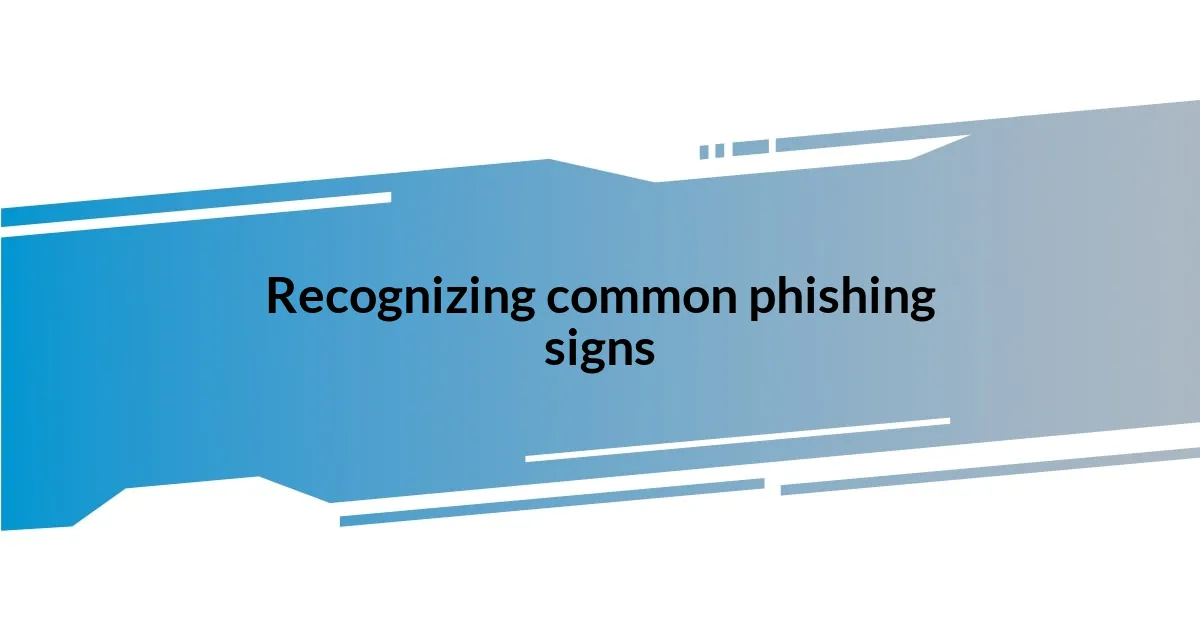
Recognizing common phishing signs
Recognizing the signs of phishing can be pivotal in navigating digital communication safely. One of the most common red flags is urgent language; a scammer often creates a false sense of immediacy. I still remember receiving an email about my account being “temporarily locked.” The anxiety I felt pushed me to almost act without thinking. This tactic exploits our instinctive reaction to threats—how often have you received a notification that demanded your swift response?
Another sign to watch out for is poor grammar and spelling. I once got a message that was just riddled with mistakes and odd phrasing. In hindsight, it seemed almost absurd, yet in the moment, it was easy to overlook when mixed with panic. Legitimate organizations usually take great care in reviewing their communications. Have you ever paused to check the quality of the language in a message? It’s a simple but effective practice that could save you from falling for a trap.
Lastly, always scrutinize email addresses and links closely. I had a moment where a link looked almost identical to a genuine one, but I noticed a tiny variation in the domain name. It’s astonishing how something so small can make a big difference. Whether it’s a character swapped or an extra letter, scammers often compromise authenticity with these tweaks. I now make it a habit to hover over links before clicking—has it become a part of your routine?
| Phishing Sign | Description |
|---|---|
| Urgent Language | Messages urging quick action often signal a scam. |
| Poor Grammar | Mistakes in writing indicate a lack of professionalism. |
| Suspicious Links | Always check links for slight variations in the domain name. |
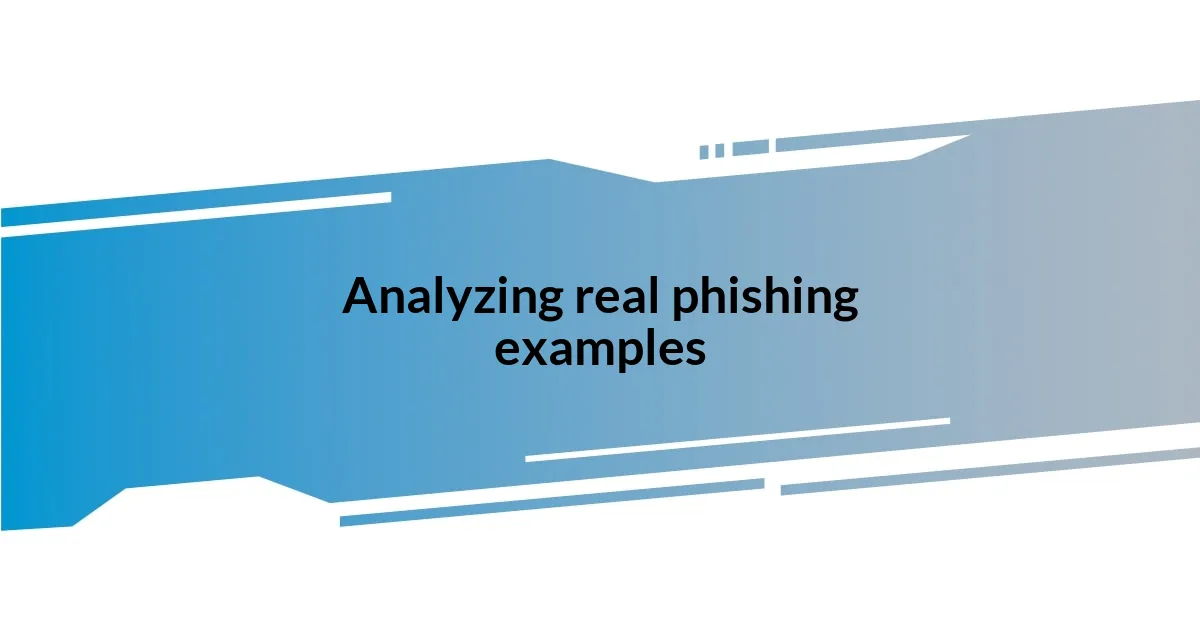
Analyzing real phishing examples
Analyzing real phishing examples gives me a clearer picture of how cybercriminals operate. I remember a fake notification from a popular streaming service claiming I had an account issue. The sense of frustration bubbled up inside me as I read, and I almost clicked on the provided link. Reflecting on that experience taught me that even well-known brands can be manipulated in phishing attempts, showcasing how scammers leverage trust to their advantage.
Here are some common phishing examples that illustrate these tactics:
- Imitative Emails: An email claiming to be from a well-known provider, using logos and colors, designed to deceive.
- Urgent Account Alerts: Notifications about account security issues that provoke panic, demanding immediate action.
- Fake Gift Cards or Promotions: Offers that seem too good to be true, enticing users to click links or provide personal information.
- Social Media Messages: Direct messages from accounts mimicking friends or family with suspicious links.
Each of these examples taps into emotions like trust and urgency, revealing just how vulnerable we can be in our digital lives.
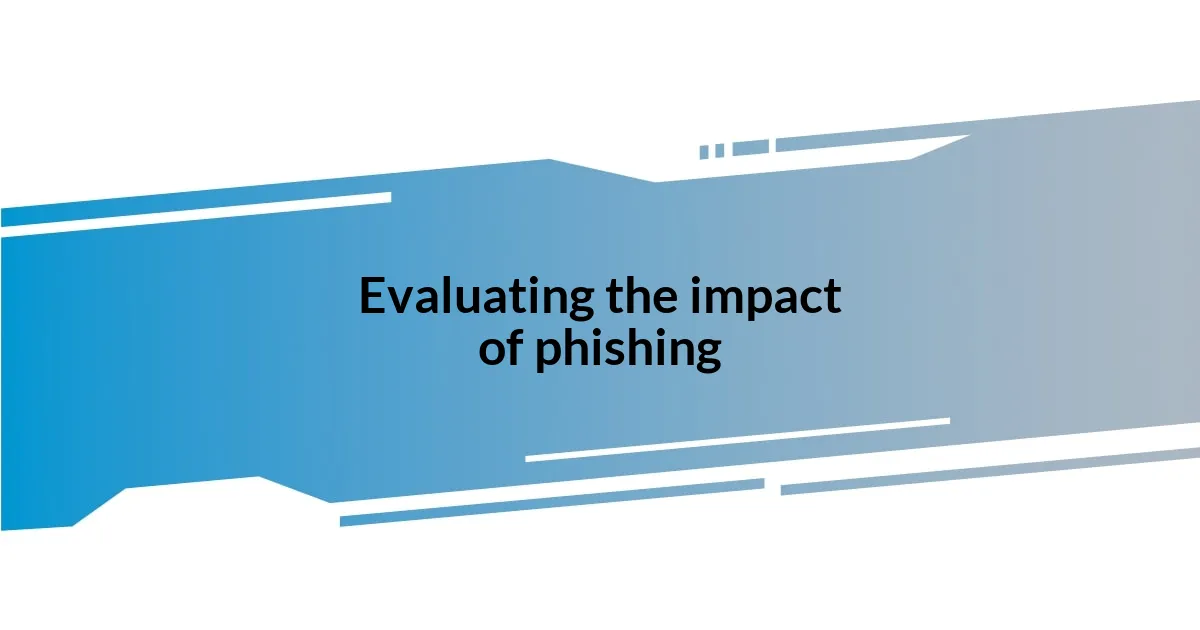
Evaluating the impact of phishing
The impact of phishing can be far-reaching, affecting not just the victims but also the businesses they interact with. I once read about a small business that suffered a significant financial loss after an employee fell for a phishing scam. It got me thinking—how many companies have to pay the price for our momentary lapses in vigilance? This kind of loss often leads to increased security measures, ultimately burdening the company and its customers.
Moreover, the emotional toll of phishing attacks can be profound. After my own near-miss with a deceptive email, I felt a wave of anxiety wash over me, a reminder of how easily our peace of mind can be shattered. I found myself constantly second-guessing every notification that popped up on my screen. Have you ever felt that gnawing sense of worry about your online security? It’s a wake-up call that reminds us of the importance of staying vigilant in a digital world that can be both convenient and perilous.
Additionally, phishing can lead to a loss of trust—not just between individuals and companies, but within our communities. I remember discussing a recent phishing incident with friends, and it was alarming how many knew someone who had fallen victim. This collective anxiety can undermine our interactions online; suddenly, we’re not as trusting, and every interaction feels like a potential risk. It raises the question: how can we foster a safer online environment while still engaging openly with one another? The answer may lie in education and awareness, creating a culture of vigilance that empowers us all.

Developing a phishing response plan
When developing a phishing response plan, it’s essential to create a clear protocol for identifying and reporting suspicious emails. I remember a time when I received an email from a source that looked familiar but had a slight variation in the email address. It made me stop and think—what if I didn’t know how to verify the sender? Establishing guidelines for staff to follow can prevent panic and ensure a calm, collected response when phishing attempts occur.
Next, the plan should include regular training sessions that educate employees about the latest phishing tactics. I’ve attended a few workshops that emphasized this, and they truly opened my eyes. The more we educate ourselves, the sharper our instincts become in recognizing red flags. I often ask my colleagues how confident they feel about spotting a phishing email, and I’m always taken aback by the mixed responses. It reinforces the idea that ongoing learning is vital in this constantly evolving landscape.
Finally, incorporating a system for assessing the response to phishing attempts can help refine and strengthen your strategy over time. After my own brush with a phishing scam, I started keeping a log of emails that seemed suspect, along with my thoughts and reactions. Reflecting on these moments not only informed my future decisions but also allowed me to share insights with others. Do you ever think about how much your immediate reactions can alter your long-term habits? By analyzing these responses, organizations can tweak their plans and create a culture of proactive vigilance that empowers everyone involved.
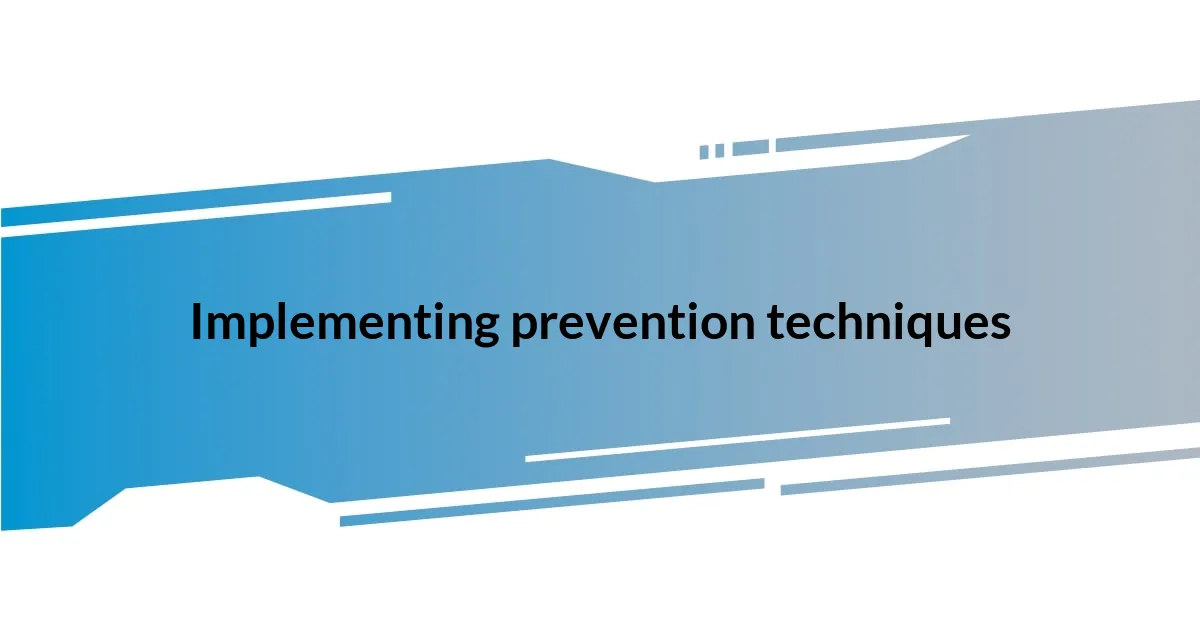
Implementing prevention techniques
Implementing prevention techniques starts with fostering a culture of awareness. I remember attending a cybersecurity seminar where the speaker shared real-life examples of phishing attempts. It was eye-opening! Knowing that these tricks are not just theoretical but happening to people every day made me realize how crucial it is to talk openly about these threats. Have you ever had a conversation about phishing with your coworkers? Just discussing it can help everyone stay alert and prepared.
One effective technique is to encourage employees to use multi-factor authentication (MFA) whenever possible. I incorporated MFA into my personal accounts, and the peace of mind it provides is invaluable. Imagine the added layer of security it brings—knowing that even if your password is compromised, an unauthorized user would still need that second verification step to gain access. It’s a small change, but it dramatically reduces the risk of falling victim to a phishing scam.
Regular simulations can also be a game changer. I once participated in a phishing test designed by my company, where we received emails that mimicked real threats. The adrenaline rush I felt when I spotted a fake email reinforced what I learned in training. These practice scenarios not only prepare individuals but also help organizations measure their overall readiness. Think about it: would you feel more confident navigating potential threats if you’d practiced spotting them in a safe environment? Absolutely! Engaging in these exercises cultivates a proactive mindset that can significantly reduce the likelihood of falling prey to phishing attacks.
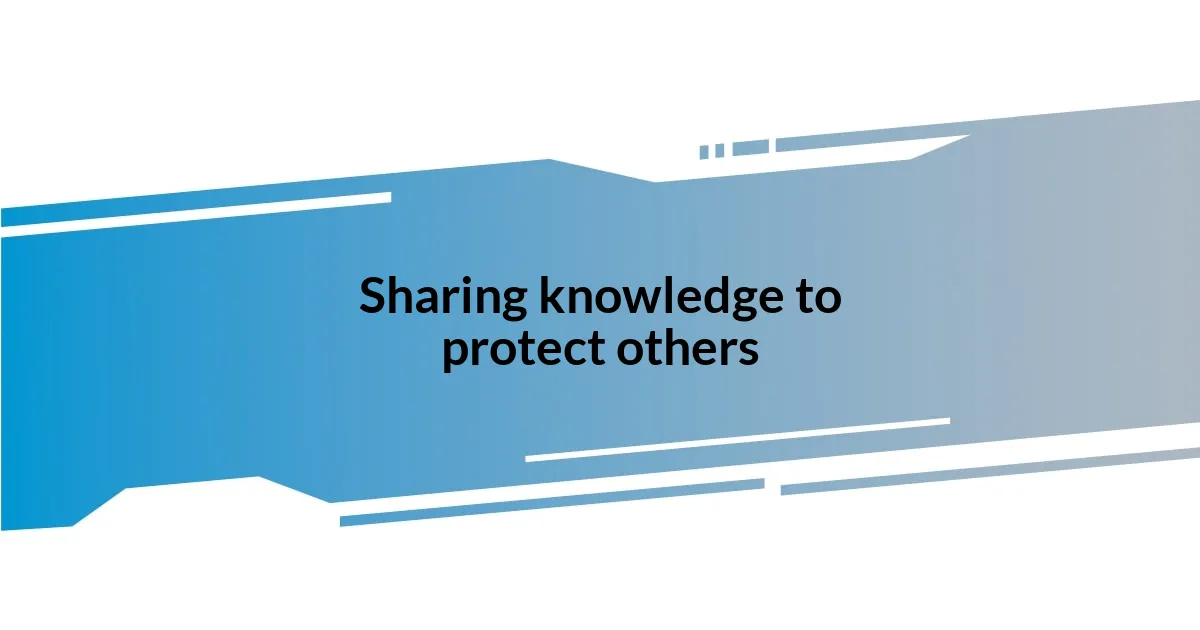
Sharing knowledge to protect others
Sharing knowledge is one of the most powerful tools we have to protect ourselves and others from phishing attacks. I’ve found that when I share my own experiences, it not only sparks conversations but also encourages others to speak up about their encounters. Have you ever noticed how a simple story can make a topic feel more relatable? By sharing what we’ve learned, we create an open environment where everyone feels empowered to ask questions and seek guidance.
I vividly recall when a colleague fell victim to a phishing scam; the fallout was significant. After that incident, we organized a casual lunch-and-learn to discuss the experience and the lessons we could draw from it. It was incredible to see how much everyone wanted to contribute. I felt a sense of camaraderie as we examined what went wrong and how we could better protect each other in the future. It made me realize that sharing knowledge isn’t just about the technicalities of spotting phishing attempts; it’s also about building a community of support and trust.
Moreover, I’ve learned that sharing knowledge doesn’t always have to be formal. Chatting with friends or family about suspicious emails can be just as impactful. I remember mentioning a phishing attempt to my parents, and it reignited their interest in cybersecurity. It was a lightbulb moment to see them grasp the importance of vigilance. Have you thought about how your discussions could influence someone else’s awareness? It’s these personal dialogues that can sow the seeds of caution and awareness, making us all a little safer.